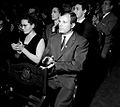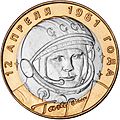Yuri Gagarin facts for kids
Quick facts for kids
Yuri Gagarin
|
|
|---|---|
 |
|
| Born |
Yuri Alexeyevich Gagarin
9 March 1934 Klushino, Russian SFSR, Soviet Union
|
| Died | 27 March 1968 (aged 34) Novosyolovo, RSFSR, Soviet Union
|
| Nationality | Soviet |
| Occupation | Pilot |
| Space career | |
| Soviet Union cosmonaut The first human in space |
|
| Rank | Colonel (Polkovnik), Soviet Air Force |
|
Time in space
|
1 hour, 48 minutes |
| Selection | Air Force Group 1 |
| Missions | Vostok 1 |
| Signature | |
 |
|
Yuri Alexeyevich Gagarin (Russian: Юрий Алексеевич Гагарин; March 9, 1934 – March 27, 1968) was a Russian cosmonaut, which is like an astronaut. He made history on April 12, 1961, by becoming the first human to travel into space. He flew in a rocket launched by the Soviet Union.
Early Life and Dreams
Yuri Gagarin was born on March 9, 1934, in a small village called Klushino in Russia. His parents, Alexey Ivanovich Gagarin and Anna Timofeyevna Gagarina, worked on a collective farm. His father was a skilled carpenter, and his mother loved to read. Yuri was the third of four children. His older sister helped take care of him while his parents worked.
Like many families in the Soviet Union, the Gagarins faced hard times during World War II. In 1943, Yuri's two older brothers and sisters were forced to work in Nazi Germany. They did not return home until after the war ended.
As a young boy, Yuri became very interested in space and planets. He dreamed of one day traveling among the stars. His teachers thought he was smart and worked hard, though he could be a bit playful sometimes. His math and science teacher had flown in the Soviet Air Forces during the war. This experience inspired young Yuri even more.
After school, Yuri started learning to be a foundryman in a metalworks factory. He was then chosen for more training at a technical high school in Saratov. While there, he joined a flight club and learned to fly small airplanes. In 1955, after finishing his technical studies, he joined military flight training at the Orenburg Pilot's School.
At the school, he met Valentina Goryacheva. Yuri married her in 1957, after he earned his pilot's wings flying a MiG-15 jet. After graduating, he was sent to an airbase near the Norwegian border. The weather there was often bad, making flying difficult. Gagarin was 1.57 metres (5 ft 2 in) tall, which was helpful because the Vostok spacecraft's cockpit was very small. He became a lieutenant in the Soviet Air Force in November 1957 and a senior lieutenant in November 1959.
Sports and Fitness
Yuri Gagarin always stayed physically fit. He was a very good sportsman. Another space explorer, Valery Bykovsky, wrote about him:
Service in the air force made us strong, both physically and morally. All of us cosmonauts took up sports and PT seriously when we served in the air force. I know that Yuri Gagarin was fond of ice hockey. He liked to play as a goalkeeper... I don't think I am wrong when I say that sports became a fixture in the life of the cosmonauts.
Besides being a good ice hockey player, Gagarin also loved basketball. He coached the Saratov Industrial Technical School team and even worked as an umpire or referee.
Journey to Space
Becoming a Cosmonaut
In 1960, after a careful search, Yuri Gagarin was chosen with 19 other people for the Soviet space program. These future space explorers went through many tests. These tests checked their physical and mental strength. They also trained hard for the upcoming space flights.
Out of the twenty people chosen, the final decision for the first flight came down to Gagarin and Gherman Titov. Both had performed very well in training and were in excellent physical shape.
First Flight into Space
On April 12, 1961, Yuri Gagarin made history. He became the first human to travel into space. He launched into orbit aboard the Vostok 3KA-3 spacecraft, also known as Vostok 1. His special code name during this flight was Kedr, which means Cedar in Russian (Russian: Кедр).
During his flight, Gagarin famously whistled the song "The Motherland Hears, The Motherland Knows" (Russian: Родина слышит, Родина знает, romanized: Rodina slyshit, Rodina znayet). The first lines of the song are: "The Motherland hears, the Motherland knows/Where her son flies in the sky". This song was written by Dmitri Shostakovich in 1951.
Some people in Western countries later said that Gagarin had commented, "I don't see any God up here" during his flight. However, these words do not appear in the official records of his conversations with Earth. A close friend of Gagarin, Colonel Valentin Petrov, said in a 2006 interview that Gagarin never said this. Petrov explained that the phrase came from a speech by Nikita Khrushchev. Khrushchev was talking about anti-religious messages and said, "Gagarin flew into space, but didn't see any God there."
Gagarin's own words from space were:
The Earth is blue [...] How wonderful. It is amazing.
Life After Space
After his amazing flight, Gagarin became a world-famous celebrity. He traveled to many countries, including Italy, the United Kingdom, Germany, Canada, and Japan. He did this to show the world the great achievements of the Soviet Union.
In 1962, he started serving as a deputy in the Supreme Soviet of the Soviet Union. This was a high-level government position. He later returned to Star City, where cosmonauts trained. There, he worked on ideas for a reusable spacecraft. Gagarin worked on these designs for seven years.
He was promoted to Lieutenant Colonel in the Soviet Air Force on June 12, 1962. Then, on November 6, 1963, he became a Colonel. The Soviet leaders wanted to protect their hero. They tried to keep him from flying in space again because they were worried about losing him in an accident. Gagarin was a backup pilot for Vladimir Komarov on the Soyuz 1 flight. When Komarov's flight ended in a deadly crash, Gagarin was officially not allowed to train for or take part in any more spaceflights.
A Hero's End
Gagarin then became the deputy training director at the Star City cosmonaut training base. At the same time, he started flying fighter planes again. On March 27, 1968, during a regular training flight from Chkalovsky Air Base, he and his flight instructor, Vladimir Seryogin, died. Their MiG-15UTI jet crashed near the town of Kirzhach. Gagarin and Seryogin were buried in the walls of the Kremlin in Red Square.
The exact cause of the crash is still not fully known. A 1986 investigation suggested that turbulence from another jet, a Su-11 'Fishpot-C' interceptor, might have caused Gagarin's plane to lose control. This other jet was using its afterburners, which create powerful air currents.
Russian documents made public in March 2003 showed that the KGB (a Soviet security agency) had looked into the accident. Their report, along with other government and military investigations, ruled out many unusual ideas about the crash. Instead, it pointed to mistakes made by air base staff. The report said that an air traffic controller gave Gagarin old weather information. By the time he flew, conditions had become very bad. Ground crew also left extra fuel tanks on the aircraft. Gagarin's planned flight needed good weather and no extra tanks. The investigation concluded that Gagarin's aircraft went into a spin. This might have been caused by hitting a bird or by a sudden move to avoid another aircraft. Because of the wrong weather report, the crew thought they were flying higher than they actually were. This meant they could not react correctly to get the MiG-15 out of its spin.
In his 2004 book Two Sides of the Moon, Alexei Leonov shared his thoughts. He was flying a helicopter in the same area that day. He heard "two loud booms in the distance." He believed a Sukhoi jet was flying too low. He thought that "without realizing it because of the terrible weather conditions, he passed within 10 or 20 meters of Yuri and Seregin's plane while breaking the sound barrier." Leonov thinks the strong air currents from this would have sent the MiG into an uncontrolled spin. He believed the first boom he heard was the jet breaking the sound barrier, and the second was Gagarin's plane crashing.
Related pages
- Gavrilin, Vyacheslav Sportsmen of the Soviet Union
Images for kids
-
Gagarin in Warsaw, 1961
-
Gagarin and Valentina Tereshkova (seated to his right) signing autographs at a youth event in 1964
-
Gagarin with U.S. Vice President Hubert Humphrey, French Prime Minister Georges Pompidou and the Gemini 4 astronauts at the 1965 Paris Air Show
-
Plaque showing Gagarin's burial place in the Kremlin Wall
-
Yuri Gagarin statue at the Royal Greenwich Observatory in London
-
Russian ten-ruble coin remembering Gagarin in 2001
-
50th anniversary stamp from Ukraine
See also
 In Spanish: Yuri Gagarin para niños
In Spanish: Yuri Gagarin para niños














